Public housing is a human right

National attention was briefly focussed on nine public housing high-rises in Melbourne’s inner north and west earlier this month when the Victorian government declared them COVID-19 infection sites, locked them down and sent 500 police to block entrances and prevent movement in and out. Two conclusions can be drawn from this extraordinary episode.
First, these residents were treated in a way no other group in society has been during this pandemic. Thousands of families and individuals on low incomes were denied the ability to seek out food, medicine and other necessities or to attend work or other crucial activities. The food supplied to residents was minimal, came days after it was promised, was often out of date and was left in corridors and foyers to be attacked by rats overnight. Residents’ movements were controlled by a small army of cops – many of them likely to be the same officers involved in the racial profiling and harassment of African residents that have been documented in the area.
For months before the lockdown, residents had been asking government and health officials to make preparations to prevent infection spreading among high-rises. Their requests were for basic things like hand sanitiser on every floor, health information distributed in the languages of the residents and increased cleaning of shared spaces. Their concerns and suggestions were ignored. Of course, that didn’t stop the victim-blaming when COVID-19 did infect the towers, led by the Grand Wizard of attacking the most vulnerable, Pauline Hanson, who slandered the residents on national television.
Even when the lockdown was lifted in most of the high-rises, police didn’t bother to remove the cyclone fencing that had been erected around some of the buildings – forming a prison yard around which police patrolled – until they were challenged and made to remove it. It is inconceivable that anyone other than public housing residents – overwhelmingly poor, working class and non-white – would be subject to such degrading treatment from government and the police.
As long as the health crisis continues, public housing residents should be provided with all the sanitation materials and personal protective equipment that they ask for. Proper food, medical and mental health support should be organised for those who need it. Safe and comfortable alternative accommodation should be made available to residents who test positive for COVID-19 and those at high risk. There should be job guarantees and paid COVID-19 leave. And all measures should be coordinated with residents’ associations or other representative bodies.
The second conclusion to be drawn is that even before the health crisis, these residents deserved better, and the situation must not go back to what it was. For the first half of the 20th century, the punishing cost of housing was something the rich understood to be a cause of bitterness and revolt among workers. Providing working class housing was widely promoted as creating a bulwark against communism. This led to a significant expansion of public housing after World War II, and rental-buying schemes from the 1950s.
Public housing today is a physical and ideological legacy of the pre-neoliberal era, and the modern Australian capitalist class resents it for this reason. In power, both major parties have let it decay where it can’t be sold off to private providers. Maintenance budgets are so low that not even a fraction of the work that’s needed to keep the homes livable and safe can be carried out. Public housing is overcrowded and has impossibly long waiting lists because of population growth and declining stock. Governments see it as an unnecessary cost and an impediment to profit making for the wealthy, developers and the banks. Running it down is a step towards doing away with public housing altogether as soon as they can get away with it.
Poor and working class people deserve good quality public housing. They deserve a chance to escape exploitative and abusive landlords in the private rental market. In the 2016 census, 116,427 people were found to be homeless across Australia, including 24,817 people in Victoria. Those people deserve a safe, stable and affordable roof over their heads.
For this to happen, massive investment in new, high-quality public housing is needed – the national waiting list in 2018 was around 140,000, so that’s a good immediate target. The Victorian government’s sell-off of public land and housing to private developers is a disgrace and should be stopped. Current public housing stocks should be renovated or rebuilt to allow fresh air, natural light and better facilities. New private, multistorey housing developments should include a minimum ratio of low-income housing. There should be a freeze on rent increases to allow incomes to catch up with ballooning housing costs, and a ban on evictions.
These changes are just a few of the many that should be implemented to meet people’s needs. They won’t be given willingly; they need to be fought for. The current crisis has exposed the criminal neglect of public housing in Victoria and created an opportunity to renew this important fight.